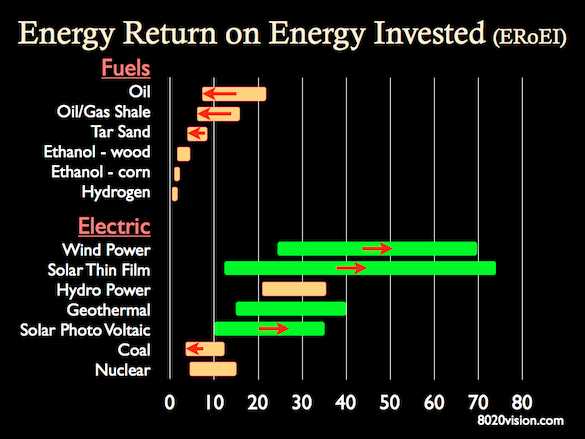What is Energy Return on Investment?
Energy Return on Investment (EROI) is a critical metric used to assess the efficiency and sustainability of energy sources and technologies. It measures the amount of usable energy obtained from an energy source compared to the energy invested in its extraction, production, and distribution.
EROI is calculated by dividing the energy output by the energy input. The energy output represents the usable energy obtained from the source, such as electricity generated from a wind turbine or oil extracted from a well. The energy input includes all the energy consumed during the entire life cycle of the energy source, including the energy used in exploration, extraction, processing, transportation, and maintenance.
Importance of Energy Return on Investment
On the other hand, a low EROI suggests that the energy source requires a significant amount of energy input compared to the energy it provides. This can have negative implications for energy security, economic viability, and environmental sustainability.
Factors Affecting Energy Return on Investment
Several factors influence the EROI of an energy source. These include the energy density of the resource, the technology used for extraction and conversion, the efficiency of the energy conversion process, and the environmental impacts associated with the energy source.
Applications of Energy Return on Investment
EROI analysis is used in various fields, including energy policy, investment decisions, and sustainability assessments. It helps policymakers and investors evaluate the potential of different energy sources and technologies, prioritize investments in renewable energy, and identify areas for improvement in energy efficiency.
EROI analysis also provides insights into the overall energy return on investment of a country or region, helping to assess energy security and identify opportunities for reducing energy dependence and promoting sustainable energy systems.
Conclusion
Calculating Energy Return on Investment
To calculate EROI, we need to consider both the energy inputs and outputs of a particular energy source. The energy inputs include all the energy required for exploration, extraction, processing, transportation, and infrastructure development. The energy outputs, on the other hand, include the usable energy that is obtained from the source.
The formula for calculating EROI is:
EROI = Energy Output / Energy Input
For example, let’s consider a hypothetical solar power plant. The energy inputs for this plant would include the energy required for manufacturing solar panels, installing them, building the infrastructure, and maintaining the plant. The energy output would be the electricity generated by the solar panels.
Once we have the energy inputs and outputs, we can plug them into the formula to calculate the EROI. Let’s say the energy output is 1000 megawatt-hours (MWh) and the energy input is 200 MWh. The EROI would be calculated as:
EROI = 1000 MWh / 200 MWh = 5
A higher EROI indicates a more efficient energy source, as it means that more energy is being obtained for each unit of energy invested. It also suggests that the energy source is more sustainable and has a lower environmental impact.
Calculating EROI can help policymakers, investors, and researchers make informed decisions about energy investments and policy development. It can also provide insights into the long-term sustainability and viability of different energy sources.
Analysis and Implications of Energy Return on Investment

EROI is a ratio that measures the amount of usable energy obtained from an energy source compared to the energy invested in its extraction, production, and distribution. A higher EROI indicates a more efficient and sustainable energy system.
When analyzing the EROI of different energy sources, it is important to consider both the direct and indirect energy inputs. Direct energy inputs include the energy required for extraction, processing, and transportation, while indirect energy inputs encompass the energy used in the production of equipment, infrastructure, and maintenance.
Implications of EROI
The EROI of an energy source has significant implications for its long-term sustainability and economic viability. A low EROI indicates that a substantial amount of energy is required to obtain a relatively small amount of usable energy. This can lead to increased costs, resource depletion, and environmental degradation.
On the other hand, a high EROI suggests that the energy source is more efficient and requires less energy input to generate a greater amount of usable energy. This can result in lower costs, reduced reliance on finite resources, and a smaller environmental footprint.
By comparing the EROI of different energy sources, policymakers, investors, and researchers can make informed decisions about the most sustainable and economically viable options. It can help prioritize investments in energy systems with higher EROI, promoting a transition towards cleaner and more efficient sources.
Factors Affecting EROI
Several factors can influence the EROI of an energy source. These include the energy density of the resource, the technology used for extraction and conversion, the scale of production, and the environmental impacts associated with its use.
Renewable energy sources such as solar and wind often have lower EROI compared to fossil fuels. However, advancements in technology and economies of scale have been improving their EROI over time. Additionally, the environmental benefits of renewable energy, such as reduced greenhouse gas emissions, can outweigh their lower EROI.
It is important to note that the EROI of an energy source can vary depending on the specific location, infrastructure, and extraction techniques used. Therefore, a comprehensive analysis of EROI should consider these factors to accurately assess the sustainability and viability of different energy systems.

Emily Bibb simplifies finance through bestselling books and articles, bridging complex concepts for everyday understanding. Engaging audiences via social media, she shares insights for financial success. Active in seminars and philanthropy, Bibb aims to create a more financially informed society, driven by her passion for empowering others.
